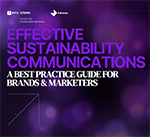 |
| Eric Fischgrund |
A Biden administration, and now a Democrat-controlled Senate and House, are set to make a big impact on the cleantech / renewable energy / sustainability sectors.
While the industry had momentum before, regardless of the distaste the Trump administration showed for the planet over the past four years, now we must prepare for takeoff.
Cleantech PR and general sustainability communications are much different than our existing practices in other “emerging technology” categories such as biotech, fintech or the Internet of Things (IoT).
That's mostly because working in the cleantech and sustainability sectors requires an understanding of all that has occurred in these sectors since 2008. Those events incudes the rise of cleantech and the obscene amount of money thrown at the solar sector during the first Obama administration; the intersection of politics and industry development, particularly at the state level with respect to tax credits; the challenges of competing with China and now the numerous, very advanced European cleantech companies; and many more.
But let’s not revisit the past (too much!) and instead look to the future of what Cleantech PR folks can expect:
- Public sentiment has changed and will continue to become one-sided. In 2020, Pew Research found that north of 60 percent of Americans consider global climate change as a major threat. Given the highly polarized emotions of an election year, I suspect that number is really much higher. That is not going to change. Despite decades of efforts to mislead the public and downplay the threat of global warming, the U.S. government is now positioned to take advantage of this public sentiment, one that will only become stronger as hurricanes, droughts, wildfires and other natural disasters continue to serve as front page evidence.
Why should PR professionals care? We can spend less time advocating for sustainability and dispelling misinformation. This enables the PR world to focus on developing very targeted messages for the investment community, industry partners and customers, instead of lecturing the general public on “coal bad, solar good,” which is so 2011. We should not squander this opportunity.
- Funding, lots of funding. You thought the Obama administration threw money at cleantech? Prepare for what’s coming by making sure your capital markets and investment community knowledge is up to snuff! Biden’s climate policy outlines just how much climate change is costing Americans, with many references in the billions, before dropping this initiative: His administration will use the Federal government procurement system—which spends $500 billion every year—to drive towards "100% clean energy and zero-emissions vehicles.” Further, any shareholder checking their stock symbols knows that the EV sector—led by Tesla—has been on fire, solar companies like SunPower have tripled their valuation, M&A activity within the battery development and energy storage sector has picked up, hydrogen fuel cell companies are booming, and more evidence abounds.
Why should PR professionals care? There are going to be A LOT of IPOs, SPAC acquisitions, private funding announcements and other financial transactions to be made. This is exciting new for cleantech PR folks who are used to dealing primarily with trade industry or specialized journalists. As the investment community, driven by ESG funds, flourishes, there will be a critical need to tell a company’s financial story directly to security holders, as well as to market journalists.
- Focusing on proof points, not just “potential.” Cleantech PR efforts a decade ago were very speculative. Thousands of companies touted “game changing, paradigm shifting” technologies that ultimately raised money, garnered headlines, and flamed out. What’s different now? Those early-stage technologies haven’t disappeared, they’ve evolved, advanced and emerged as not only commercially viable, but highly effective. Virtual power plants are popping up all over the U.S. An EV sighting is no longer unique, it’s commonplace. Major big box retailers are using hydrogen fuel-cell technology to power forklifts and trucks onsite.
Why should PR professionals care? It’s difficult to tell the story of companies who are forever in R&D or whose technology pivots every 12 months”—a historical challenge in cleantech PR. Now, we must prepare to focus on localized efforts, touting projects and installations that change communities, before presenting to a more national and mainstream audience on how such programs can serve as a blueprint around the country and world. Having a cool story is great, having proof points is better.
I could go on, but I’ll leave it with these big three points. Cleantech PR professionals, whether at a sustainability-focused agency or managing communications internally, must understand why these next two, and maybe four, years will be different, and prepare to take advantage of this environmentally-friendly political environment.
***
Eric Fischgrund is the founder and CEO of FischTank PR, a leading sustainability and cleantech PR firm.


 Gen Z’s concern for environmental issues is a reflection of living in a world fraught with uncertainty, underscoring the importance for brands to craft messages that align with this generation’s values.
Gen Z’s concern for environmental issues is a reflection of living in a world fraught with uncertainty, underscoring the importance for brands to craft messages that align with this generation’s values. Effective sustainability messages can also kickstart a brand’s reach and relevance, according to new research from the NYU Stern Center for Sustainable Business and Edelman.
Effective sustainability messages can also kickstart a brand’s reach and relevance, according to new research from the NYU Stern Center for Sustainable Business and Edelman. Austin-based Treble offers pro bono PR services to greentech start-ups with financial backing.
Austin-based Treble offers pro bono PR services to greentech start-ups with financial backing. Publicis Groupe has acquired London-based sustainability communications shop Salterbaxter with plans to align the firm under MSLGroup.
Publicis Groupe has acquired London-based sustainability communications shop Salterbaxter with plans to align the firm under MSLGroup.


 Have a comment? Send it to
Have a comment? Send it to 
No comments have been submitted for this story yet.